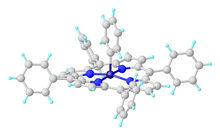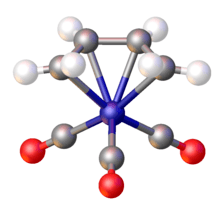Organoiron chemistry
Organoiron chemistry is the chemistry of iron compounds containing a carbon-to-iron chemical bond.[1][2] Organoiron compounds are relevant in organic synthesis as reagents such as iron pentacarbonyl, diiron nonacarbonyl and disodium tetracarbonylferrate. Iron adopts oxidation states from Fe(−II) through to Fe(VII). Although iron is generally less active in many catalytic applications, it is less expensive and "greener" than other metals.[3] Organoiron compounds feature a wide range of ligands that support the Fe-C bond; as with other organometals, these supporting ligands prominently include phosphines, carbon monoxide, and cyclopentadienyl, but hard ligands such as amines are employed as well.
Iron(0) and more reduced states
Carbonyl complexes
Important iron carbonyls are the three neutral binary carbonyls, iron pentacarbonyl, diiron nonacarbonyl, and triiron dodecacarbonyl. One or more carbonyl ligands in these compounds can be replaced by a variety of other ligands including alkenes and phosphines. Disodium tetracarbonylferrate, "Collman's Reagent," can be alkylated followed by carbonylation to give the acyl derivatives that undergo protonolysis to afford aldehydes:[4]
- LiFe(CO)4(C(O)R) + H+ → RCHO (+ iron containing products)
Similar iron acyls can be accessed by treating iron pentacarbonyl with organolithium compounds:
- ArLi + Fe(CO)5 → LiFe(CO)4C(O)R
In this case, the carbanion attacks a CO ligand. In a complementary reaction, Collman's reagent can be used to convert acyl chlorides to aldehydes. Similar reactions can be achieved with [HFe(CO)4]− salts.[5]
Alkene-Fe(0)-CO derivatives
Monoalkenes
Iron pentacarbonyl reacts photochemically with alkenes to give Fe(CO)4(alkene).[6]
Diene-Fe(0)-CO derivatives
Iron diene complexes are usually prepared from Fe(CO)5 or Fe2(CO)9. Derivatives are known for common dienes like cyclohexadiene, norbornadiene and cyclooctadiene, but even cyclobutadiene can be stabilized. In the complex with butadiene, the diene adopts a cis-conformation. Iron carbonyls are used as a protective group for dienes in hydrogenations and Diels-Alder reactions. Cyclobutadieneiron tricarbonyl is prepared from 3,4-dichlorocyclobutene and Fe2(CO)9.
Cyclohexadienes, many derived from Birch reduction of aromatic compounds, form derivatives (diene)Fe(CO)3. The affinity of the Fe(CO)3 unit for conjugated dienes is manifested in the ability of iron carbonyls catalyse the isomerisations of 1,5-cyclooctadiene to 1,3-cyclooctadiene. Cyclohexadiene complexes undergo hydride abstraction to give cyclohexadienyl cations, which add nucleophiles.[7]
The enone complex (benzylideneacetone)iron tricarbonyl serves as a source of the Fe(CO)3 subunit and is employed to prepare other derivatives. It is used similarly to Fe2(CO)9.
Alkyne-Fe(0)-CO derivatives
Alkynes react with iron carbonyls to give a large variety of derivatives. Derivatives include ferroles (Fe2(C4R4)(CO)6), (p-quinone)Fe(CO)3, (cyclobutadiene)Fe(CO)3 and many others.[8]
Tri- and polyene Fe(0) complexes
Stable iron-containing complexes with and without CO ligands are known for a wide variety of polyunsaturated hydrocarbons, e.g. cycloheptatriene, azulene, and bullvalene. In the case of cyclooctatetraene (COT), derivatives include Fe(COT)2,[9] Fe3(COT)3,[10] and several mixed COT-carbonyls (e.g. Fe(COT)(CO)3 and Fe2(COT)(CO)6).
2.svg.png)
Iron(I) and iron(II)
As Fe(II) is a common oxidation state for Fe, many organoiron(II) compounds are known. Fe(I) compounds are almost always feature Fe-Fe bonds.
Ferrocene and its derivatives
The rapid growth of organometallic chemistry in the 20th century can be traced to the discovery of ferrocene, a very stable compound which foreshadowed the synthesis of many related sandwich compounds. Ferrocene is formed by reaction of sodium cyclopentadienide with iron(II) chloride:
- 2 NaC5H5 + FeCl2 → Fe(C5H5)2 + 2 NaCl
Ferrocene displays diverse reactivity localized on the cyclopentadienyl ligands, including Friedel-Crafts reactions and lithation. Ferrocene is also a structurally unusual scaffold as illustrated by the popularity of ligands such as 1,1'-bis(diphenylphosphino)ferrocene, which are useful in catalysis.[11] Treatment of ferrocene with aluminium trichloride and benzene gives the cation [CpFe(C6H6)]+. Oxidation of ferrocene gives the blue 17e species ferrocenium. Derivatives of fullerene can also act as a highly substituted cyclopentadienyl ligand.
Fp2, Fp−, and Fp+ and derivatives
Fe(CO)5 reacts with cyclopentadiene to give the cyclopentadienyliron dicarbonyl dimer ([FeCp(CO)2]2), called Fp2. Pyrolysis of Fp2 gives the cuboidal cluster [FeCp(CO)]4.
Reduction of Fp2 with sodium gives "NaFp", containing a potent nucleophile and precursor to many derivatives of the type CpFe(CO)2R.[12] The derivative [FpCH2S(CH3)2]+ has been used in cyclopropanations.[13] The complex Cp(CO2)Fe+(η2-vinyl ether]+ is a masked vinyl cation.[14]
Fp-R compounds are prochiral, and studies have exploited the chiral derivatives CpFe(PPh3)(CO)acyl.[15]
Alkyl, allyl, and aryl compounds
The simple peralkyl and peraryl complexes of iron are less numerous than are the Cp and CO derivatives. One example is tetramesityldiiron.

Compounds of the type [(η3-allyl)Fe(CO)4+X− are allyl cation synthons in allylic substitution.[6]
Sulfur and phosphorus derivatives
Complexes of the type Fe2(SR)2(CO)6 and Fe2(PR2)2(CO)6 form, usually by the reaction of thiols and secondary phosphines with iron carbonyls.[16] The thiolates can also be obtained from the tetrahedrane Fe2S2(CO)6.
Iron(III)
Some organoiron(III) compounds are prepared by oxidation of organoiron(II) compounds. A long-known example being ferrocenium [(C5H5)2Fe]+. Organoiron(III) porphyrin complexes are numerous.

Iron(IV) and higher oxidation states
In Fe(norbornyl)4, Fe(IV) is stabilized by an alkyl ligand that resists beta-hydride elimination.[18] Organoiron(IV) and Iron(V) are represented by [Fe(porphyrin)]2C and its cationic derivative.[19] Two-electron oxidation of decamethylferrocene gives the dication [Fe(C5Me5)2]2+.
Organoiron compounds in organic synthesis and homogeneous catalysis
In industrial catalysis, iron complexes are seldom used in contrast to cobalt and nickel. Because of low cost and low toxicity of its salts, iron is attractive as a stoichiometric reagent. Some areas of investigation include:
- Link</ref>[20][21]
- Hydrogenation and reduction, example catalyst Knölker complex.
- Cross-coupling reactions. Iron compounds such as Fe(acac)3 catalyze a wide range of cross-coupling reactions with one substrate an aryl or alkyl Grignard and the other substrate an aryl, alkenyl (vinyl), or acyl organohalide. In the related Kumada coupling the catalysts are based on palladium and nickel.
- Complexes derived from Schiff bases are active catalysts for olefin polymerization.[22]
Biochemistry
In the area of bioorganometallic chemistry, organoiron species are found at the active sites of the three hydrogenase enzymes as well as carbon monoxide dehydrogenase.
See also
- Chemical bonds of carbon with other elements in the periodic table:
| Compounds of carbon with other elements in the periodic table | |||||||||||||||||||||||||||||||||||||||||||||||||||||||||||||||||||||||||||||||||||||||||||||||||||||||||||||||||||||||||||||||||||||||||||||||||||||||||||||||||
|---|---|---|---|---|---|---|---|---|---|---|---|---|---|---|---|---|---|---|---|---|---|---|---|---|---|---|---|---|---|---|---|---|---|---|---|---|---|---|---|---|---|---|---|---|---|---|---|---|---|---|---|---|---|---|---|---|---|---|---|---|---|---|---|---|---|---|---|---|---|---|---|---|---|---|---|---|---|---|---|---|---|---|---|---|---|---|---|---|---|---|---|---|---|---|---|---|---|---|---|---|---|---|---|---|---|---|---|---|---|---|---|---|---|---|---|---|---|---|---|---|---|---|---|---|---|---|---|---|---|---|---|---|---|---|---|---|---|---|---|---|---|---|---|---|---|---|---|---|---|---|---|---|---|---|---|---|---|---|---|---|---|
| |||||||||||||||||||||||||||||||||||||||||||||||||||||||||||||||||||||||||||||||||||||||||||||||||||||||||||||||||||||||||||||||||||||||||||||||||||||||||||||||||
References
- ↑ Synthesis of Organometallic Compounds: A Practical Guide Sanshiro Komiya Ed. S. Komiya, M. Hurano 1997
- ↑ Iron-Catalyzed Reactions in Organic SynthesisCarsten Bolm, Julien Legros, Jacques Le Paih, and Lorenzo Zani Chem. Rev. 2004, 104, 6217-6254 doi:10.1021/cr040664h
- ↑ Enthaler, S.; Junge, K.; Beller, M. (2008). "Sustainable Metal Catalysis with Iron: From Rust to a Rising Star?". Angew. Chem. Int. Ed. 47: 3317–3321. doi:10.1002/anie.200800012.
- ↑ Organic Syntheses, Coll. Vol. 6, p.807 (1988); Vol. 59, p.102 (1979). Link
- ↑ Brunet J.J. (1990). "Tetracarbonylhydridoferrates, MHFe(CO)4: Versatile Tools in Organic Synthesis and Catalysis". Chem. Rev. 90 (1041–1059): 1041. doi:10.1021/cr00104a006.
- 1 2 D. Enders1 , B. Jandeleit , S. von Berg (2002). "(+)-(1R,2S,3R)-Tetracarbonyl[(1-3η)-1-(Phenylsulfonyl)- But-2-en-1-yl]iron(1+) Tetrafluoroborate". Org. Synth. 78: 189. doi:10.15227/orgsyn.078.0189.
- ↑ A. J. Birch and K. B. Chamberlain (1973). "Tricarbonyl[(2,3,4,5-É≈)-2,4-cyclohexadien-1-one]iron and Tricarbonyl[(1,2,3,4,5-É≈)-2-methox-2,4-cyclohexadien-1-yl]iron(1+) Hexafluorophosphate(1-) from Anisole". Organic Syntheses. ; Collective Volume, 6, p. 996
- ↑ C. Hoogzand, W. Hubel (1968). "Cyclic Polymerization of Acetylenes by Metal Carbonyl Compounds". In Wender, I.; Pino, P. Organic Syntheses via Metal Carbonyls Volume 1. Wiley. ISBN 0-471-93367-8.
- ↑ D. H. Gerlach, R. A. Schunn, Inorg. Synth. volume 15, 2 (1974) doi:10.1002/9780470132463.ch1
- ↑ Lavallo Vincent, Grubbs Robert H (2009). "Carbenes As Catalysts for Transformations of Organometallic Iron Complexes". Science. 326 (5952): 559–562. Bibcode:2009Sci...326..559L. doi:10.1126/science.1178919. PMC 2841742.
- ↑ Petr Stepnicka "Ferrocenes: Ligands, Materials and Biomolecules" J. Wiley, Hoboken, 2008. ISBN 0-470-03585-4
- ↑ Keith H. Pannell; Hemant K. Sharma (2010). "(Cyclopentadienyl)dicarbonylmethyliron ((η5-C5H5)Fe(CO)2CH3, FpMe), a Seminal Transition-Metal Alkyl Complex: Mobility of the Methyl Group". Organometallics. 29: 4741–4745. doi:10.1021/om1004594.
- ↑ Matthew N. Mattson; Edward J. O'Connor; Paul Helquist (1998). "Cyclopropanation using an Iron-Containing Methylene Transfer Reagent: 1,1-Diphenylcyclopropane". Organic Syntheses. ; Collective Volume, 9, p. 372
- ↑ Tony C. T. Chang, Myron Rosenblum, Nancy Simms (1988). "Vinylation Of Enolates with a Vinyl Cation Equivalent: trans-3-Methyl-2-vinylcyclohexanone". Org. Synth. 66: 95. doi:10.15227/orgsyn.066.0095.
- ↑ Karola Rück-Braun "Iron Acyl Complexes" in Transition Metals for Organic Synthesis. Vol. 1. 2nd Ed., M. Beller, C. Bolm, Eds. Wiley-VCH, 2004, Weinheim. ISBN 3-527-30613-7.
- ↑ King, R. B., "Organosulfur Derivatives of Metal Carbonyls. I. The Isolation of Two Isomeric Products in the Reaction of Triiron Dodecacarbonyl with Dimethyl Disulfide", J. Am. Chem. Soc., 1962, 84, 2460.
- ↑ Pascal Doppelt (1984). "Molecular stereochemistry of low-spin five-coordinate phenyl(meso-tetraphenylporphyrinato)iron(III)". Inorg. Chem. 23: 4009–4011. doi:10.1021/ic00192a033.
- ↑ B. K. Bower and H. G. Tennent (1972). "Transition metal bicyclo[2.2.1]hept-1-yls". J. Am. Chem. Soc. 94 (7): 2512–2514. doi:10.1021/ja00762a056.
- ↑ Cao, C.; Dahal, S.; Shang, M.; Beatty, A. M.; Hibbs, W.; Schulz, C. E.; Scheidt, W. R. (2003). "Effect of the Sixth Axial Ligand in CS-Ligated Iron(II)octaethylporphyrinates: Structural and Mössbauer Studies". Inorganic Chemistry. 42: 5202–5210. doi:10.1021/ic030043r. PMC 1993896.
- ↑ See also Organic Syntheses, Coll. Vol. 6, p.1001 (1988); Vol. 57, p.16 (1977). Link
- ↑ See also Organic Syntheses, Coll. Vol. 6, p.996 (1988); Vol. 57, p.107 (1977). Link
- ↑ Allan, L. E. N.; Shaver, M. P.; White, A. J. P. and Gibson, V. C., "Correlation of Metal Spin-State in alpha-Diimine Iron Catalysts with Polymerization Mechanism", Inorg. Chem., 2007, 46, 8963-8970.


